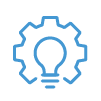
Last updated June 20, 2023
When online marketing is used as a channel to achieve a strategic competitive advantage, a continuous process of step-by-step improvement is required. Improvement upon improvement is like interest-on-interest or compound interest. Achieving improvement upon improvement ultimately means exponential growth. To achieve desired goals, it is not enough, for example, to optimize meta titles once, or to set up only one Google Ads campaign and not look back at it again.
Achieving a sustainable competitive advantage requires continuous improvements. The interest-on-interest effect of these improvements is a strong driver of growth. Every business owner should be aware of this in order to make better decisions.
Play iterated games. All the returns in life, whether in wealth, relationships, or knowledge, come from compound interest.
- Naval (@naval) May 31, 2018
Exponential growth
The interest-on-interest effect creates exponential growth. Exponential growth is a term that gained much notoriety during the corona crisis due to ever-increasing infection rates. Yet it remains a complex concept for many people because our brains think linearly. The definition of exponential growth is an increase proportional to its own size. So 2 + 2 or 4 + 4. Any quantity that keeps growing by the same percentage per unit of time is growing exponentially. As in this sequence: 2-4-8-16-32-64. The increase is always a doubling and the growth is ever increasing.
Examples of exponential growth
Chess
A great example to explain exponential growth is the story about the inventor of chess. As thanks for his invention, the king allowed him to make a wish. He wanted 1 grain on the first square of the chessboard, 2 on the second square, 4 on the third and so on, always double the number on each subsequent square. So 1-2-4-8-16-32 etc. That doesn't seem like much, but with 64 spaces, the final number of grains became a whopping 20-digit number: 18,446,744,073,709,551,615. That's huge exponential growth.
The eighth wonder of the world
Albert Einstein saw compound interest as the eighth wonder of the world. A bank gives interest on the money in a savings account. As long as that money remains including the interest, the bank gives interest on the total again. So every year, more and more, because of the interest-on-interest effect. As a result, the balance grows by ever larger amounts of interest. This too is exponential growth.
The formula for calculating interest-on-interest is:
FV stands for future value, PV for present value, i is the interest rate/100 and n is the number of periods. A calculation example:
Suppose € 10,000 is in a savings account with 3 percent interest per year, for 10 years. The calculation is then: € 10,000 * (1 + 0.03) ^10= € 13,439.16. In the 1st year the interest is € 300 and in the last year € 391.43.
Relevance to online marketing
Compound interest can greatly benefit any business or organization, both at the general business level and in online marketing. The interest-on-interest effect fits seamlessly with Tasmanic's vision of online marketing, based on the incremental approach. The goal is to ensure that each adjustment, small or large, adds measurable value. In the long run, these incremental performance improvements are extremely powerful. For example, every year 20% growth in organic website visitors yields ~149% growth after 5 years. Even stronger is the effect when performance improvements are also achieved in other online channels. Think: in addition to 20% more SEO traffic achieve a 5% lower CPA in Google Ads and a 0.5% higher conversion rate across all channels website traffic. Continuously measuring data and adjusting all online marketing parameters accordingly can therefore lead to very large, positive results.
How can the interest-on-interest effect occur in business operations and online marketing?
- Company level: revenue growth over revenue growth.
- Company level: growth rate growth.
- Business level: business value growth over business value growth.
- In SEO: each year 20 growth in organic website visitors is 149% more visitors in 5 years.
- In SEA: every year a 5% lower CPA is over 27% lower CPA in 5 years.
- In CRO: each year 0.5% better conversion rate is 2.5% higher conversion rate in 5 years.
As an entrepreneur, what can you do with the interest-on-interest effect?
The interest-on-interest effect is so powerful that the human brain has a hard time grasping it. Recognizing the power as an SME entrepreneur can provide a significant competitive advantage.
- Be sure to measure the KPI’s on which you want to make progress
- Ensure progress (in sales, margin, market share), even if it is only a small amount of progress in a bad year
- Make more progress (in sales, margin, market share) than your competitor to strengthen your position
- Include a multi-year pass-through in any decisions you make. The interest-on-interest effect can also be negative: missed growth also piles on missed growth with disastrous consequences for your competitive position.
Is your company missing opportunities?
Request our no-obligation performance scan

















 Team
Team FAQ
FAQ Vacancies
Vacancies Contac
Contac AWR
AWR Ahrefs
Ahrefs Channable
Channable ContentKing
ContentKing Leadinfo
Leadinfo Optmyzr
Optmyzr Qooqie
Qooqie Hubspo
Hubspo Semrush
Semrush





